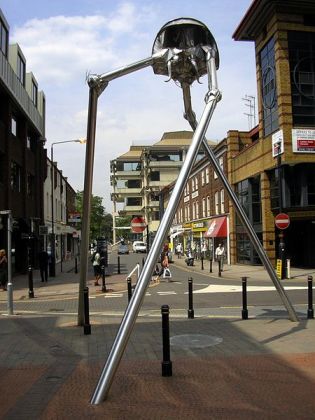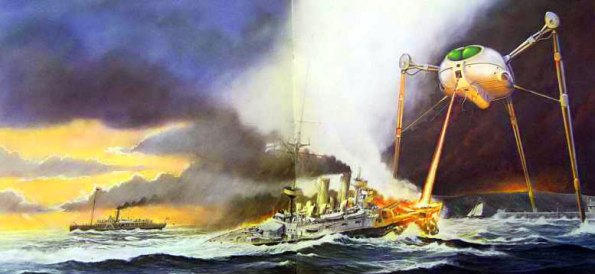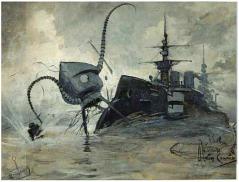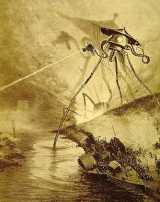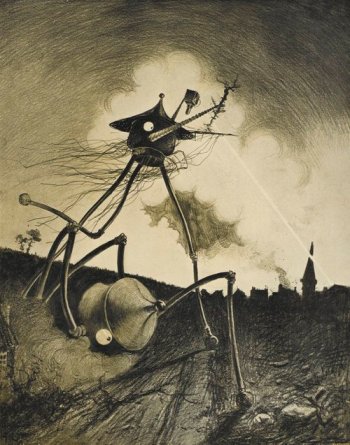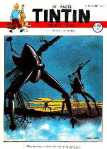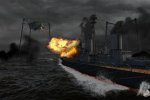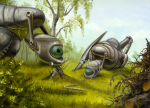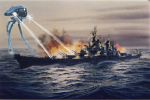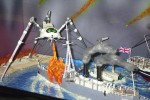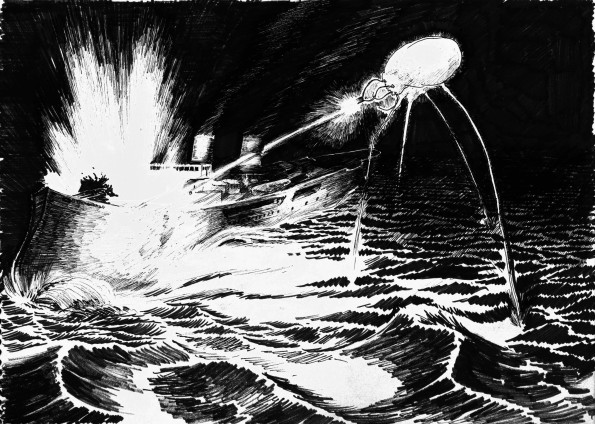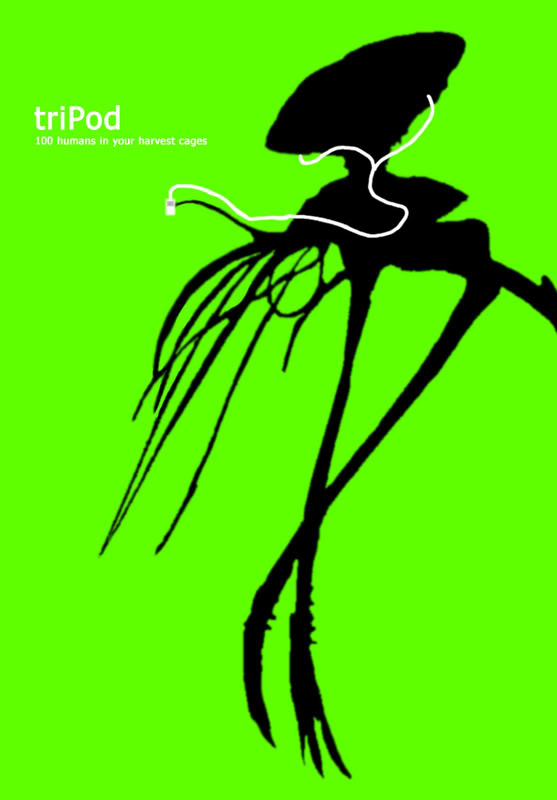Archive
A brief history of tripods
When H G Wells read about the Black War, he found himself thinking “Jesus fuck! What if I wrote a book where aliens came and invaded the British Empire right in its stupid fucking face, and were just genocidal assholes just like the British Empire in Tasmania? What then?”
So he did. And he made the British Martian invaders as disgusting and evil and alien and just wrong as he could. And late one night, hopped up on cheap Turkish tobacco, he had an epiphany: “nothing in nature has three legs, does it? These fuckers gonna be three-legged. Then you’ll know how bad they are.”
The next morning he realised why nothing in nature has three legs: because as soon as it tried to move, it would fall over. So he wrote that instead of walking his three-legged monsters rolled like “a milking stool tilted and bowled violently along the ground.”
The reading, drawing and movie-making public totally agreed with him about the awesomeness of alien invasions and the awesome alienosity of three legged fighting machines. “Fuck yeah, tripods!” they said, all around the world. Even, curiously, in Woking, which he wrote about being flattened and destroyed first and most thoroughly.
But there was less enthusiasm for the “bowling along” rationalization and even less for remembering the whole Tasmanian genocide thing. Which just goes to show that gonzo-imaginative beats sensible, meaningful, and important every time, when it comes to grabbing the public’s excitement glands.
So why am I blogging this, when you can get perfectly good histories of Wellsian Tripods from Wikipedia or the War of the Worlds Wiki? I’ll get to that.
I reckon the next really important moment in Tripod development was Mike Trim’s iconic 1978 painting:
which you probably know from Jeff Wayne’s Progopera. By the time Trim did this, there had already been 80+ years of tripod drawing:
but these hapless tin-men weren’t exactly going to (ahem) set the world on fire. Aside from a tendency toward big heads and spindly legs there wasn’t much consensus about what a Martian tripod should look like – people knew they wanted tripods but they didn’t agree on exactly what that meant.
(amazing gallery of book covers – from which extracts below;)
until two versions pretty much killed all the others. Trim’s, which was really a polished up take on this 1950s effort:
and a beetle-shell, overhanging eaves look that Spielberg would adopt mostly just to avoid agreeing that Trim totally nailed it (lots more views here and here)
that probably derives ultimately from a comic book (the original of which I haven’t tracked down):
So what’s so great about Trim’s painting?
1: it’s a spider. A daddy long legs like you find in the shower.
2: it has two glowing eyes. Other pictures make it clear that those are supposed to be compound bug-type eyes but here they make a recognisable, almost-human face.
And 3: that face is pure scorn. Trim’s tripod threatens without having to move because it melts the Thunderchild’s valiant heart with pure contempt. That’s not just the haughty angle of the head, it’s also the not bothering to dodge pose of the legs and most of all the I shot you right where I wanted to angle of the heat ray. Compare this Spanish hatchet job, where they messed with the painting to fit a narrow format:
Here the face is looking down its murderous nose at nobody. The ship isn’t going to hit it anyway so there’s no question of dodging. In fact maybe it just did dodge, like a bullfighter, and is dropping the rejón de muerte as the Torpedo Ram blunders past. It’s contemptuous, but not idly so.
And so just how iconic is Trim’s painting? How much does it dominate the imaginative landscape? Ahem:
OK. But the real reason I went off down this rabbit-hole is that I saw a godawful bit of lazy 3D and I had to share it in the right context.
See, the confrontation of the Thunderchild and the tripod is one of the big scenes in the book. It’s the definitive moment when the reader understands that the British Empire – and therefore humanity – is completely screwed. The Thunderchild is not the Empire’s biggest ship, but it is its most spitefully violent. It is an outstandingly stupid idea realized as expensively as possible – a ship made to destroy things utterly, no matter how Pyrrhic the victory. It’s a fucking giant steam engine made to ram things with torpedos. And it gets one good strike on a spindly leg before the Martians wise up and melt it. So you’d want that scene to be pretty dramatic, right? Something like this:
only there the drama rather gets in the way of the clarity of what exactly is going on.
Trim’s painting gives you drama, futility, scorn, tragedy and clarity in one neatly pointed triangular composition.
And then we come to this flabby bit of 3D rendering, which gives you absolutely none of that, plus a boring alien cannon doohickey:
Yes, it’s sticking a tentacle up in the air creating tension with the edge of the frame. The horizon line is off communicating a loss of control. And like Trim’s picture we see the point of the Thunderchild’s sacrifice – the steamer full of civilians escaping to France.
But Ugh. Zero character, zero tension. It could be a picture about air pollution. In spite of the fact that the Thunderchild is clearly just about to run that sucker down on pure momentum. It’s… just…
Here, have some alterna-tripods as a palette cleanser:
Still here? This Goliath thing looks like it could be fun. And look, tripod minis! The old Tin Man rides again! Roger Dean’s version as a model. And finally Fimm McCool’s Orkshop has an actually fairly original design!
I could use that.
An essay on monsters in response to Noisms’ essay on war
Dammit, sometimes Noisms writes posts that would require a huge essay for me to respond to them properly. And, y’know, actual thinking. His latest kinda demands a moral response, but I try to avoid boring you guys with my idiosyncratic and probably indefensible moral outlook. So I’m not going to get into how “evil” is not an analytical category but an expression of reaction “in the eye of the beholder.” Or how JB’s comment on the original post shows the gulf of difference in interpretations that even the horrors of war can elicit.
Instead I’m just going to write about why I find monsters useful (even though I use a lot of “human” opponents in my games). for brevity I’ve condensed my ideas into bullet points. They look like statements of dogma but please assume lots of hedging about with “it seems to me that” and “my personal philosophical position is” and “here’s a dodgy contention…”. Also they’re pretentious, but that’s what you get when you provoke thoughts.
What are monsters for?
1. Yes, nothing is worse than humans. Except some other bits of nature, which are also horrific if only we stop to think about them. Being real, people contain all the awfulness we can all collectively imagine, while monsters as individual acts of imagination can at best/worst hope to express some portion of that awfulness.
2. But monsters are still useful because they’re selectively awful. Art is always an act of selection/deletion. The universe acts and means everything all at once, it’s great and terrible and petty and boring and we don’t know what to do with it. But art can tease out some subset of the whole experience so we can have a guided reaction to it – go in one direction rather than being pulled in all directions and going nowhere. As works of art monsters can mean something rather than everything/nothing more narrowly and purely than people can.
3. So monsters are somehow illustrative or evocative – metaphors for aspects of people or situations or events. They express reaction to those events (fear, horror, caution), not the events themselves. That doesn’t mean they have to be didactic or translatable into some manifesto of meaning: goblins can just be goblins, but as goblins they’re also a tight little knot of associations and sensations. Like wine tasting – yes you can pull your sensation of wine apart and identify the soil and climatic conditions and notes of fruit and wood and so on, but you also have a glass of something that tastes of wine.
4. Monsters offer some freedom of association for each player’s imagination, and therefore room for creativity. Games, like books, offer incomplete descriptions, which allows each player to fill in their own details, horrors and meanings. Those meanings might be a kind of payoff for each player, but also the individual act of finding meanings, of knotting up those associations that the game stirs up, is a kind of payoff itself.
5. They are capable of being neutral tokens in a game of risks and challenges, and such tokens are necessary to allow the more abstract elements of the game to flourish. The chess pawn represents a troop or column or platoon or something of infantry, but more importantly in the context of the chess game it represents a specific set of moves: when the pawn is taken it’s not useful to the game to see those men injured – the human cost of war – because in its primary reality as a token, the loss of a pawn is really an opportunity cost in a set of possible moves between players. Blood on the board would detract from the intent of the game, which is primarily architectural. RPGs are hybrids, less pure in intent than chess, but they can contain chess-like elements, which are helped by a certain level of abstraction.
Sometimes people say “you can kill monsters and it’s OK because they’re evil.” This falls into a trap (in thinking, it’s not just that it opens an opportunity for argumentative people) because it conflates 2 things: (a) the abstract token cited above and (b) an idea of necessary or justified violence based on moral judgment (which is a whole other can of worms I am not gonna get into thanks you probably don’t really want to know my inadequate and untested civilian’s ideas about that). Rather, I would prefer to say “here is a game where killing monsters is part of the activity. That may raise some tricky questions if you stop to think about it, but it also allows us a space to put up some easily-understood challenges, of the kind which allow players to express their problem-solving creativity.” Or something similar but less wordy.
6. Maybe monsters are necessary to the figure of the hero, who expresses hope and faith in our ability to “win” – to succeed in the face of difficulties. We often think in terms of exchanges, and very often these are zero-sum exchanges: costs for things won or produced or found.* In this way of thinking, if there are winners there must be losers. So a conspicuous winner must leave a trail of losers/victims in their wake. Monsters are a way of identifying those who should lose.The necessary and correct enemies or obstacles for the hero to overcome, to enact their function as a hero.
As an ideational category monsters are a useful and dangerous tool: propaganda deploys monsters to represent the enemies of the state, which most often means depersonalizing people to permit violence against them. But the monster is also a useful way of imagining, say, cancer or pollution as a problem which it will take intelligent action to overcome. When we call scientists heroes or award them medals (as though they were coming home in triumph from military campaigns or from the potlach-war of Olympic contests), we are figuring their achievements into the hero/monster idiom.
What happens if you drop a gelatinous cube into the Tumbling Dungeon?
This, by the way, is also what the formless spawn of Azoth looks like when it’s wandering around a vertical dungeon and refusing to fall apart like a proper liquid would. Only black. And here’s Telecanter’s tumbling dungeon.
…there are moments in that movie where it really looks like some spirit or shroud of a ghost rising to wreak its terrible vengeance, and moments when it looks exactly like a liquid, and moments when its sharply cut edges are spooky all by themselves.
So thinking about Telecanter’s hall of four spheres*** it occurs to me that the Indiana Jones billiard ball is not the only hazard that could be flopping aimlessly around an unstable dungeon surface. And checking back on the old Gel Cube I find I like it more than I remember. I’d always thought of it as (a) a stupid trick by a bored DM and (b) a simple herding device for a recalcitrant party. But what if you’re investigating the lair of the mad alchemist or wizard? Isn’t this exactly the sort of experiment you’d half expect to find? And what if the party are sleeping or resting or incapacitated in the dungeon by other threats? Isn’t this just the kind of thing to make them wish they were more alert?**** Why do folks love the Shoggoth and hate the Cube?
So how could this elderly trainwreck of a monster provide some additional fun? First I’d say make it hard to burn, and have it do damage to armor first – that’d give even your recently paralysed MU one round of clothing protection before he’s Cubefood. Mechanically, I’d say the Cube doesn’t get stuck if the corridor’s a bit too small: it’s deformable enough that if there’s a hole under it that’s more than, say, 70% of its area, it will slowly sink into it, and keep sinking until it finds a new cubic space to occupy.* Oh, and the whole “slow” thing; I say Cubes and shoggoths alike aren’t slow as such, they just have poor acceleration and deceleration. They can speed up or slow down by 1mph (or say 3mph for shoggoths) a round, up to a maximum of 60-70mph. Certainly fast enough to do lots of damage to themselves and anything else in their way (a 10′ cube of water is more than 30 metric tons!). And they can turn, say, 90 degrees per round, -10 degrees for every 1mph they’re currently going forward. So most times you encounter them they’re just moving like supertankers in port: slowly and carefully. But if they get a good head of steam up as they run off the cliff into the lake they’ll tumble and bounce and skip across the surface. At least a couple of times.
Then:
1. What if it were averse to something – salt, say? Or attracted to catnip or fresh meat? Then the PCs could herd it around the dungeon themselves. But it won’t go through closed doors – it doesn’t feel a gap. And if it comes to the end of a corridor it’ll reverse. Long-term dungeon inhabitants will know all these tricks, of course.
2. See how it doesn’t digest dungeon walls? Clearly there’s some list of what’s digestible. Clearly you could carry offcuts in indigestible flasks or larger containers and use them as… artillery ammo? Because it won’t splash but it’s a pain to get rid of once it’s in your granary/breastplate/stable. And I don’t see why you shouldn’t be able to snip bits off it – the mechanics for “defeating” it are vague about just what that means. I’d allow cutting weapons to sever it, thereby turning one big hazard into lots of smaller ones.
3. Alchemists are always “digesting” stuff in their flasks. Now it’s a treasure/McGuffin: go get me some Gel. And like Spawn up there, it doesn’t want to be used, so you’ll have to chase it around the dungeon once it’s realised it shouldn’t be chasing you. And it can knock stuff over and close doors and slip down cracks and into the sewer system. And it can swallow all the keys, even if it can’t use them.
4. because “mindless” just isn’t fun. It should have some sort of intelligence, just an entirely alien one. It should know enough that it could find a lair, sneak out at night and paralyse/digest a couple of cows or children, and then disappear by morning. So you start finding these bleaching skeletons around the place and frightened villagers but no explanation. And if it’s not water-based but something else altogether then it might show up in deserts or volcanoes or as the unintended consequence of universe-rending dimensional gates and passwalls.
5. Of course if it is water based it might be able to alter its size/viscosity in water. Drinking water. Which gives me an idea for displacement puzzles – do you have to float a boat/platform/statue, flood an area, swim up somewhere? Get the Cube into the water column and see how much taller it gets (I’ll spare you all my computer adventure game type weight-on-a-seesaw, catapult, airlock, hydraulic and wobbly floor puzzles. You get it). With the right breadcrumb trail and an indigestible howdah you could enlist it to carry stuff out of the dungeon for you.
6. Or like an anemone it could adopt a different shape in water. And/or like a nudibranch it could swim surprisingly efficiently, turning a slow, lumbering land threat into a serious (magical) lake guardian.
7. What if it could communicate, like Thumper, by slapping on the ground, sending booming waves of shock around the dungeon? Who/what would it call? What if it could break through thin sections of wall/floor or crumbling stone bridges?
8. What if it’s one form of the last “stone” left over from constructing the sky and therefore theologically highly important? What if you could compress it into an ooze golem? What if it brought you stuff – clues – to lead you around the dungeon to the cheese, and eventually enticed you into the mindswap device, the same trick its current mind fell for many years ago? Then you could have the fun of taking the mindswapped character’s player into the next room and offering them a choice: either continue as the Cube or play for a while as a ringer for the DM – someone who’s trying to pose as the player’s previous PC but who knows nothing about the story so far, and who had their own reasons for coming down into this dungeon all those moons ago.
* No, I’m not going to model the mass to surface tension ratio or viscosity on this thing: my sense is that if it’s about as dense as water and somehow manages to maintain a cube shape then it could probably be repurposed as some kind of super-material, so hand-waving is all you’ll get here.
** Telecanter, when are you going to link all these posts together or provide an index page or something? This is awesome stuff and it deserves to be collated and popped on Links to Wisdom. srsly.
*** put the cube and the spheres together and you get… a big mess? Bits of caustic jelly everywhere? Deadly pinball? Something that can move the balls around so they go places gravity wouldn’t just push them?
**** yes the being digested to death thing is suitably icky, but I’d guess it kills mostly by suffocation. 10′ of water is considerable pressure, but not a crush attack. But if it falls on you it’ll do… 2d6 per 10′ of fall? And engulf you instantly.
On mere valour
Toynbee convector offers an extract on the extraordinary bravery of some exterminated Inca.*
If I were running a smart-ass Vancian or Lieberian 4-colour fantasy I would certainly include Goblin and Kobold bards who sang the bitter defeats and astonishing sacrifices of their brethren into immortality. I would have the self-righteous humans pick these songs up on broadsheets and propagate them, sometimes changing the names or fitting them to their own tragedies of war, sometimes rendering them as romances or fantasies, sometimes simply repeating them verbatim and adopting their heroes as universal icons. They’d be chanted on playgrounds and chain gangs. Maybe these laments would not be accepted in the salons of power until they’d been gussied up, arranged for string band and majestic horns, their themes all but submerged in a layered, repetitive formalism. Maybe nobody would know that the Marcus Garvey or Che Guevara or Olaudah Equiano of my world was a Kobold, maybe they’d know but it wouldn’t matter. Maybe none of that would change the humans’ genocidal urges.
Alas, I missed scurvy awareness day.
While I’m tilting at sacred cows, here‘s a nice analysis of the British royal family as a brand. I actually think none of the four worlds the author describes is quite the one we live in, each of them could be a nice graft onto your own snoozing former empire.
* I’m not going to make any friends around here posting about my discomfort with the implicit politics of a relentless stronghold-raiding game – its colonialism, its orientalism, its racism, its historical echoes or its home ethnicity, its reliance on unexplained categories like “good” and “evil.” For me, these days, part of the attractive puzzle of the game is that I nonetheless find it puzzlingly attractive, despite its many unattractive qualities. I hope you can enjoy this post without being derailed by this note.
The kerosene whale
The kerosene whale is the world’s only source of lamp oil. In addition to the highly sought after, and highly flammable, eponymous oil, it provides source material for a wide variety of waxes, preservatives and mordants. Its baleen is used in fashion, in combs and for magicians’ quills, its jawbones make perfect howdah bows for the larger dinosaurs and its eyes, pickled, can be sold at good prices to alchemists. Unsurprisingly it has all but withdrawn from the shores of civilisation: whaling expeditions must now venture far out into the uncharted Sea of Tar to find their prey.
Only fully mature whales have the huge subcutaneous mixed oil deposits that make hunting profitable. Now that kerosene whales have begun traveling in pods up to a score strong, those adults are protected by juveniles who, lacking the large nose-bulbs of their parents, are confident to attack the ships sent after them, sometimes co-ordinating their strikes to capsize large vessels and drag sailors down to the depths in whirlpools.
Whalemen and sages agree that the whales have changed their behaviour because of human hunting. Most dismiss as paranoid raving the suggestion that they are reacting specifically to the use of live kerosene whales as floating bombs in the recent wars. How, they ask, could the whales know? They are, after all, only monsters.
Update: of course the sages could resolve this problem if only they had City of Iron’s whale speech.
Not even a monster. With apologies to PPnM
There is a wyrm native to the coastal kingdom of Ghanaligh, hundreds of feet long but the thickness of a stout rope, which can control the colours of its iridescent, shimmering scales to make any pattern or image. Its body is somewhat deformable and prone to elaborate coiling: it loves to lie pancake-flat on oriental rugs or hang from rods masquerading as a tapestry. It has no claws and only weak fangs, laced with a poison that provokes sleep or ravenous hunger. It is chiefly prized for its breath weapon, however, a cloud of illusion-inducing smoke, covering a 30′ cube. The illusions are controlled by the dragon’s will but filtered through the victim’s interpretation: they are considered prophetic by the longtail adepts of the far west. They always begin with the removal of all threats and a sensation of peace (the dragon, if spotted, might be shown escaping or melting into air or otherwise being neutralized), and continue as long as the dragon remains nearby. Anyone affected will have their morale raised and concentration lowered by 1d4 for 30-CON hours and may be subject to shreds or suggestions of illusion for years afterward.
Away from Ghanaligh the dragon’s scales become dull and lose their colour-changing ability. Those of the maghreb are said to be red or black, and notably resinous.
No. Enc.: 1-4
Alignment: you decide. OR Chaotic Good
Movement: lethargic unless frightened. Then 50′ a round. Cannot jump
Armor Class:3. It’s hard to see and dodges well, but it’s also a great big rope
Hit Dice: 5
Attacks: bite (1d3 plus save vs. poison: 1-3 sleep: 4-6 hunger compulsion)
Save: F5
Morale: 10
XP: 20. What are you doing attacking this harmless, peaceful creature? And no, its effects do not remind me of anything else. It’s about the wonder of childhood. Honestly!
Don’t call them Githyanki
For James’ latest bandwagon: the Githyanki have had plenty of ink spilled over them, some of it legal. I feel I have a right to reimagine them, though, because I read about them once in the 1980s, lost my source book and have since played a deep trench around them, using them (or something vaguely remembered about them) in almost every one of my occasional forays into roleplaying over the past 15 years. Drop the name and everything else except the FF cover then and this will be wholly original content, creative commons whatever, go for it.
Update : This Githyanki beats all my efforts, dammit, with the single phrase They build their fortresses on the petrified bodies of dead gods adrift in the void. Ah well. Here’s mine anyhoo.
HD = PCs’ level +3; AC 0; Atk 1 weapon of choice* (1d6 + save vs poison or be taken over); Move 6; Always lose initiative. Str: 25, Dex: 8, weight in armor: half a ton. Special: weapons are drugged. They always want labor so they’re most likely to try to capture rather than kill outright. Damage is non-lethal unless they’re up against a stone golem or something that’s obviously undruggable, in which case they get out the big guns (literally: requires two creatures to fire, 6d6, one attack per round).
When they enter your game it will be through a gate that links directly to their icy home world. They appear in teams of a size appropriate to the task at hand but never less than 5. They will be fully covered in a dark, opalescent armour that is as smart as they are and might actually be in command. They only gate in to seize very specific items or conduct very specific missions, which they do on contract for whatever evil sorcerors you might have. They are absolutely ruthless but easily distracted or confused – away from home they’re in a hostile alien environment and will die within 12 hours if unable to get back through the gate. Their operation window is always limited, and their objectives clear. They will work single-mindedly to achieve them and be careless about lost men or equipment.
I generally use them as an explicitly alien threat, like Greys or Mi-go – you know something is badly wrong when they show up. If you’re not prepared they are generally unstoppable, but they won’t try to exterminate you unless you keep being in their way. The key to dealing with them is to find out who contacted them and what deal they struck, so really, like other summoned entities, they’re a Mcguffin that leads to an antagonist. And just like the creatures themselves, the deals they strike are generally highly idiosyncratic and inexplicable: they’ll want a particular scroll or a book from a secret library or exotic ingredients or a signing stone. They’ll want the contacter to find it because they haven’t been able to locate it through their magics, and they’ll be willing to do services in return. But they’ll always want just a bit more – the ingredient won’t work and they’ll blame the contacter, or it will and they’ll suddenly need a lot more of it. And once they know where a contacter is they can gate in whenever they have a gap in their schedule. The urge to capture is also a plot point: if they seize you they will take you to whoever contacted them. If the contacter doesn’t have specific instructions regarding what to do with you then you’ll be kept in their castle as a guinea pig or set to work in their spice mines. Or they might use you as an interpreter on their next ingredient-finding mission.
* their weapons, like all their equipment, will be weird and difficult to use – crossbows mounted directly into alien gauntlets, dart guns that have 3 rounds in the magazine tipped with unknown drugs, floppy scimitars leaking greenish liquid. Their gear is camouflaged to work in their own iridescent, flickering world: it stands out like a sore thumb anywhere else, and may light up inconveniently in the presence of whatever the hell. Sages will be able to tell you where else stuff like that was seen, but are unlikely to know anything about the creatures that use it, except that they’re probably working for someone. If you somehow manage to assemble a complete suit of armor and prise the creature out of it, the armor will quietly and persistently suggest (save vs rods staves and wands each day, rolled in secret) that somebody put it on. Then it will be impossible to take off again. The armor will continue to suggest that its wearer should go to the next gate site. Once there, if the gate is open it will try to take over the wearer (save vs rods at +4, -the number of days in the armor) and get back home. Every day the wearer spends in the armor they will lose 1d6lbs, until they take on the withered appearance of the creatures and have lost half their original weight and hit points.
Timor Tom, cloud leviathan
Most of Matt Kish’s illos are just his own thing. 
This, though, is clearly a monster for an RPG.
Timor Tom, cloud leviathan.
No. Enc: unique
HD: irrelevant. OK fine, 60,000,000.
Move: with the wind, or up to 50mph against it
AC: -2/20. It’s a flying island. It won’t dodge. But it’s covered in yards of crystalline armour. Try crawling into an orifice and see if you find something vulnerable.
Other stats: not very important. Except it’s nearly immune to magical intervention, and spells cannot be used within 100 feet of it.
LOA: 2 miles
Turning circle: 200′
Attacks: brush against – save or die from crushing. Swallow whole: begins new cavern adventure inside the beast. Maybe lightning? From piezo-electric effect when he stresses the crystals on his back? Ooh: breath weapon – save or be displaced 500 feet in a random direction.
Because few people have seen Timor Tom in clear weather, let alone at close quarters, he’s commonly imagined as a rather diaphanous, woolly sort of whale, a playful spirit who calms storms, rather than provoking them. He’s even propitiated during the islanders’ children’s festival as a kind of beneficent guardian spirit.
Nothing could be farther from the truth. Tom is hard as rock and mad as hell. But he’ll crumble to table salt if he touches the ground or anything in contact with it, so he’s only a menace to birds, flying characters, and lookouts at mast-heads.
What especially infuriates him is that, being inconveniently large, he can’t do much about creatures on his back, and he’s become home to a tribe of blue-skinned sky-devils. Occasionally they step off him into the clouds, running their errands, and very occasionally he catches them at it, and then it’s a tense time for everyone, but the sky-devils are just about invisible to anyone who only has 3 kinds of cones in their eyes, and Tom falls in that benighted category. Tom hopes one day to befriend a Roc and be rid of the sky-devils forever. So far he hasn’t met one that wanted anything to do with him however. He’s starting to dislike them on principle.
He dreams sometimes about diving into the ocean and drowning the blue men, but he fears that, even if contact with the sea itself is not fatal to him, he might never get airborne again.
Tom can speak many languages, but communicating with him is not easy. He hears messages best if they’re shouted inside his ear-caverns. His voice is painfully loud up close, and from a distance merely sounds like rumbling thunder. He can read Latin and Arabic (but only in decorated early Kufic presentations) fluently.
UPDATE: dammit, swords and dorkery points to a whole raft of Escher I somehow hadn’t seen before, and the very first picture lays this whole conceit bare. I guess I’m just an unconscious parodist of MC.
Another sort of monster
Timor Tom has me thinking about another skyborne menace. A hardshell giant twice the length of a man, which throws out clamshell claws full of stingers when it closes to attack. If it sinks its barbs into you then you’d better strike it back and hard, or it’ll just hang on with its spiderweb strands all the time you’re running away, until it has you snarled up and tired out – then all its claws will lash you at once. If you do hit it back, on the body or claws, it’ll spill wriggly, crunchy maggots. But to dent its breast and bring it to down to the scavengers on the cold gritty bottom you have to charge it so hard you risk rupturing yourself.
(UPDATE: this is turning into a really interesting little demonstration of the contention that people will comment on commentary but not on content)
Formless spawn of Azoth
Part Cthulhuvian horror, part alchemetic elixir, the Formless Spawn of Azoth is an intelligent black oil, which can shape itself however it chooses. It is also caustic – touching it inflicts 1d4 damage.
Its intelligence depends on the amount of liquid gathered together in a single body: in small quantities it behaves like any normal liquid but a cube 1 foot high* has intelligence (and size) 1 (enough to attack and to hunt for more Azoth). A cube 3 feet high (roughly the volume of a stereotypical pirate’s barrel) has intelligence/size 3, a 10-foot cube has intelligence/size 10.** The maximum is intelligence 20: larger bodies of Azoth exist, but they are no more intelligent.
Its real strength is its ability to assume and hold forms. One of its favourite tricks is to masquerade as a labyrinth. A 10′ cube can stretch itself to form an 80′ corridor or two 20′ square rooms or any other combination of spaces and switchbacks.*** It will lure a party of adventurers in by making noises at the farther end, then continually add rooms in front of them, taking them away behind, until it has them where it wants them. It can hold small items, like door knobs, to augment the illusion. It’s also fond of masking pits and chasms. If prompted to attack it can collapse onto the party inflicting 1d8 damage per round to each person until the adventurers manage to free themselves.
And it’s a magical ingredient, a necessary component of the philosopher’s stone and a host of other magic items, spells and potions. Usually sold in very small flasks.
It is said that the great alchemist Agathodaimon worked closely with Azoth: he called it an indispensible help and the keeper of his memory palace.
No. Enc.: 1
Alignment: you decide
Movement: 120’ (40’)
Armor Class:10
Hit Dice: 5hp per point of Int/Siz (note, unlike Int, there is no ceiling for HP)
Attacks: Siz 1-2: 1d4. Siz 3-6: 1d8. Siz 7-9: 2x 1d8. Siz 10-15: 3x 1d8. Siz 16-19: 4x 1d8. Siz 20+: 5x 1d8. Or “tunnel collapse:” 1d8 per round until you save vs Str -encumbrance.
Save: F10
It can be hurt only by fire or by magic weapons.
Morale: 10
XP: 2,500
If encountered in a stand-up fight (a rare occurrence) the number of attacks it gets per round depends on its size/intelligence (see stats). These attacks take whatever form you like – long ropy strangling tentacles, mouths that spit Azoth at faces, great wallowing waves, stabbing spears, gloopy attempts to get inside the PCs’ armour…
It can move in short, fast bursts but can’t sustain a pace much faster than a running man.
If set on fire it will try to shed the burning parts to keep from being entirely consumed (save or take burn damage again next turn. Recalculate size from current HP. Quickly, now! No, sod it; just abstract to 3 basic sizes: initial, barrel size (when 15hp are left) and 1 cu. ft/5hp).
It is imiscible with water but avoids rivers because running water is inimical to its magical nature (save vs confusion/paralysis each round).
If it’s so smart, why does it hang out in places where PCs all come with torches? See 9and30’s “I meant to do that” for advice of/on genius. I reckon if it can it arranges for a strong smell of naphtha or open barrels of gunpowder or some other fire deterrent in the anteroom of its hideout. Anyway, burning Azoth is probably not at all good for you. The smoke alone. You make that up.
Why doesn’t it divide into many pieces to get more overall attacks per round? Because it would rather make the best decisions each round as the figh develops, and it doesn’t trust its less-intelligent sub-selves to do that. Maybe it also fears mutiny from some of its less trustworthy impulsive sides.
* 7.5 US gallons. or about an anker.
** Calculating volumes sucks, and a linear relationship between volume and Int would quickly lead to hyper-intelligent spawn. The Int/Siz rating here is a fudge for convenience’s sake. Anyway, all these numbers are rough. Wing it. The reason I’m sweating a bit about the size to intelligence ratio is that it affects the monster’s versatility and threat level. Something man-sized with human intelligence is trouble like Terminator 2, while something small enough to hide in your Guinness that’s still smart enough to cut the brakes on your car is a campaign all on its own.
*** OK, here we go with the volumes. It can encompass 8 times its own volume. So a Siz 5 spawn is just big enough to make a 10′ box, a SIz 11 could cover 10 squares of 10’x10′, Siz 12 can do 14 squares, Siz 15 could do 27 squares and Siz 20 could do 64. I know the surface area goes strange for differently shaped volumes, the reason it doesn’t get a free pass for doing a single giant bubble chamber with a high ceiling is then it needs more buttressing, OK?
Also in my Flash Gordon games this is secretly what the priesthood of Klytus are; man-size bodies uniformly possessing 15 Int. Individual priests are expected to return to the main pool periodically to share their experiences and receive new orders (something they are not always keen to do). They tend to be creatures of few words: compared with the hard work of talking, keeping the glass eyes and gold mask in place, even when asleep, is trivial.
